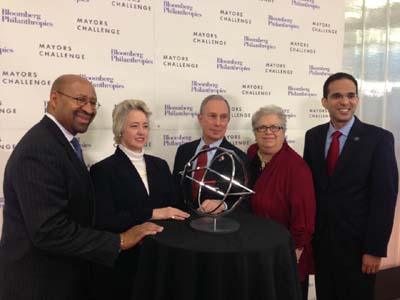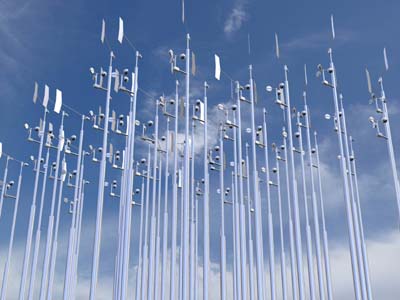Santa Monica’s Public Art Trove Grows
Staff Writer
April 17, 2013 -- When Santa Monica was awarded $1 million in Bloomberg Philanthropies’ Mayor’s Challenge Competition for its innovative Wellbeing Project, the City got more than a check to cash. Also offered was a new addition to the civic art inventory -- a sculpture from famed Danish -- Icelandic artist Olafur Eliasson.
The nine-pound untitled sculpture will be displayed “in a location accessible to the public like the city manager’s office, or in the corridors of City Hall,” Cultural Affairs Manager Jessica Cusick said.
 |
| Santa Monica Mayor Pam O'Connor poses with New York Mayor Michael Bloomberg and Eliasson (photos courtesy of City of Santa Monica) |
The Eliasson sculpture will join another piece of public art, “Weather Field” by Chicago artist Inigo Manglano-Ovalle, to broaden the City’s collection of public art even further.
 |
| "Weather Field" by Manglano-Ovalle |
Though some in the city may not be aware, Santa Monica has acquired an impressive collection of contemporary art since a City resolution came about in 1984. The works purchased or donated over the years include some of the more important artists of the latter 20th century, like Ed Ruscha, Rico Lebrun, James Turrell and Ed Moses.
“We decided back in the early 80s that the City should have a unified vision of public art,” said Bruria Finkel, one of the founding directors of the City’s cultural arts program.
“We wanted to feature lots of California artists like Ed Ruscha, but with equal opportunity for male and female artists and minorities,” she said.
The resulting trove has created an Art Bank, with works that are a representational definition of public civic art.
Much of the city’s collection -- which is rotated around the city, usually found gracing local libraries, business offices and public walkways -- is currently on display at the Annenberg Community Beach House, until the end of the month.
And many of the works are perfect examples of the kind of public/private collaboration the city would like to employ in building the collection, Finkel said.
The primary funding for “California Wash, 1996,” installed at the end of Pico Boulevard between Shutters and Casa del Mar hotels, was originally from a private donation. A number of artists’ requests for bids were accepted before narrowing a proposal down to five artists, including “California Wash” by Newton and Helen Meyer Harrison.
The couple, known for their environmental and ecologically-themed work, provided a maquette -- or model -- of their installation and their work was overwhelmingly preferred in public commentary.
“Like with the dinosaurs on the Promenade, we always sought public commentary on any proposed public art commission,” Finkel said. “With ‘California Wash,’ people in Santa Monica became even more aware of our ecological issues through art.”
For Julie Rusk, assistant director for community and cultural services, the Eliasson piece was just icing on the cake of a project that will benefit Santa Monica residents indefinitely.
“The Mayors Challenge was about big ideas that address government accountability for community benefit,” Rusk said. “Our job over the next two years with the Wellbeing Project is to create an index of the measurable health of a community: physical, mental, economical and cultural.”
The goal is to allow cities to examine the intersections of government and social responsibility to see how they can best promote an environment where residents thrive.
“What are the conditions that enable people to flourish,” Rusk asked, only half rhetorically. “The way we create public spaces and allocate resources, like with Tongva Park and the 'Weather Field' piece, says a lot about who we are as a community.”
Though establishing an index of community wellbeing might be new to the U.S. -- and specifically to Santa Monica -- the concept is not entirely without precedent. The king of Bhutan famously coined the term “gross national happiness” back in 1972 as the flip side to the importance of “gross national product.”
In developing a “Happiness Index,” the Centre for Bhutan Studies recognized sustainable development, cultural integrity, ecosystem conservation and good governance as essential to a thriving community. Cultural vitality is one of those pillars of strength. According to Rusk, these elements are integral to developing an effective Wellbeing Index.
For Finkel, the proposed Ocean Avenue Project -- a hotel, restaurant, retail and museum space -- designed by Frank Gehry, is a perfect example of the kind of public/private art symbiosis that will maintain a cultural vitality for the city.
“This is a big thing for the city,” Finkel said. “This kind of work is an impetus for us to create important buildings and through them, invite important art to the city.”